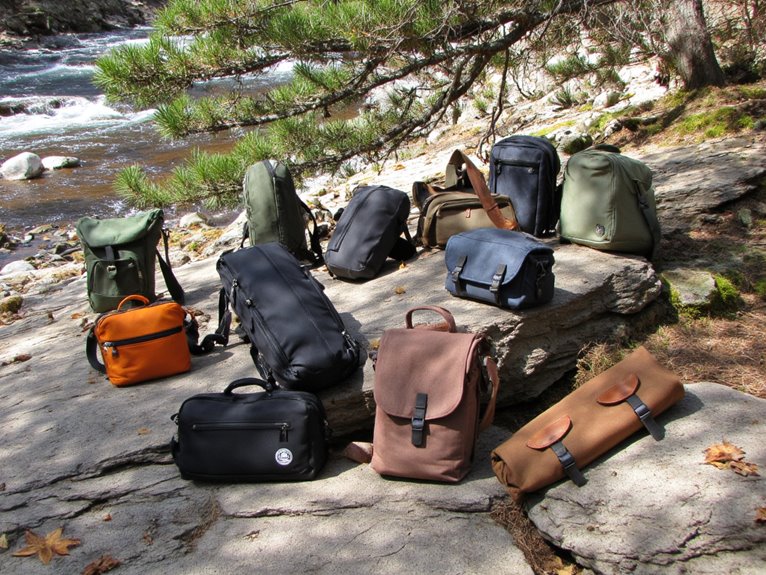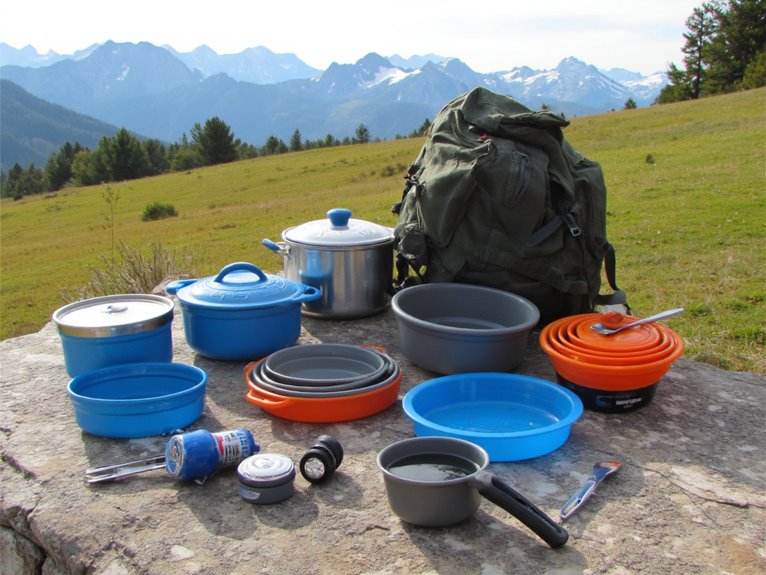How Big of a Bear Canister Do I Need?
To determine the ideal size of a bear canister, calculate the total volume of food, scented items, and trash you need to store, considering trip duration, group size, and personal gear requirements. Evaluate the weight and bulk of food, personal hygiene items, and cooking gear to guarantee sufficient storage space. Allocate at least 1-2 liters of storage capacity per person per day and plan accordingly. Consider the number of days in the wilderness and corresponding supplies needed. By accurately evaluating your storage needs, you'll be well-equipped to select the right canister size for a safe and enjoyable wilderness experience.
We are supported by our audience. When you purchase through links on our site, we may earn an affiliate commission, at no extra cost for you. Learn more. Last update on 1st January 2026 / Images from Amazon Product Advertising API.
Determining Your Food Storage Needs
When planning a backcountry trip, accurately evaluating your food storage needs is crucial to guarantee you bring the right size bear canister, as it directly impacts the amount of space available for other essential gear.
To determine your food storage needs, calculate the total volume of food and scented items you plan to bring.
Consider the weight and bulk of your food, as well as any personal hygiene items, toiletries, and trash.
Be sure to include any cooking gear, such as pots and utensils, that may also require storage.
Trip Duration and Canister Size
Calculating trip duration is a critical factor in determining the ideal bear canister size, as it directly correlates with the amount of food and scented items that need to be stored.
The longer the trip, the more supplies you'll need to carry, and the larger the canister required.
For short trips, a smaller canister may suffice, but extended trips demand a larger capacity to accommodate the increased amount of food, trash, and scented items.
When calculating trip duration, consider the number of days you'll be in the wilderness and the corresponding amount of supplies needed.
This will help you determine the optimal bear canister size to ensure you have sufficient storage space for all your gear.
Group Size and Storage Capacity
In addition to trip duration, the number of people in your group is a critical factor in determining the ideal bear canister size, as it directly impacts the overall storage capacity required.
A larger group means more food, trash, and scented items to store, necessitating a larger canister.
As a general rule, a bear canister should provide at least 1-2 liters of storage capacity per person per day.
For example, a group of three people on a four-day trip would require a minimum of 12-24 liters of storage capacity.
When choosing a bear canister, consider the number of people in your group and plan accordingly to guarantee you have sufficient storage space for all your gear.
Types of Items to Store Safely
Beyond food and trash, a wide range of scented items, including personal hygiene products, clothing with food or lotion stains, and even certain medications, must be safely stored in a bear canister to prevent attracting unwanted wildlife.
These items can emit odors that attract bears, and improper storage can lead to serious consequences.
Other items that require safe storage include cooking gear, dish soap, and toothpaste.
Even empty food packaging and dirty diapers must be stored properly to avoid attracting bears.
It's essential to carefully consider all scented items in your group's possession and plan accordingly to guarantee a safe and responsible wilderness experience.
Calculating Your Storage Requirements
When calculating your storage requirements for a bear canister, it's essential to evaluate the volume of food and trash you need to store.
This includes not only the quantity of food but also its packaging and any other items that require safe storage.
Food and Trash Volume
Accurately calculating your food and trash volume is essential to selecting the right-sized bear canister for your outdoor adventure.
To do this, consider the number of people in your group, the length of your trip, and your food storage needs.
Estimate the volume of your food, trash, and scented items, such as toothpaste and soap.
A general rule of thumb is to allocate 1-2 gallons of storage space per person per week.
For example, a 3-day trip for two people would require approximately 1-2 gallons of storage space.
Be sure to include space for any bulky items, such as fuel canisters or bear spray.
By accurately calculating your food and trash volume, you can confirm you have a bear canister that meets your needs.
Storage Space Needed
To determine the storage space needed for your bear canister, consider the total volume of your food, trash, and scented items, as well as any bulky items that require additional space. This calculation will help you choose the right-sized canister for your needs.
When calculating your storage requirements, be sure to account for:
- Food: compacted and organized to maximize space
- Trash: including packaging and food waste
- Scented items: toiletries, clothing, and other items with fragrances
- Bulky items: camp chairs, bear bag accessories, or other gear
- Personal items: clothing, first aid kit, and other essentials
Note: This calculation should provide an accurate estimate of the storage space needed for your bear canister.
Choosing the Right Canister Size
Selecting a bear canister that is the right size for your needs is essential, as it directly impacts the weight and bulk you'll carry on your back.
A canister that's too small may force you to leave essential items behind, while one that's too large will add unnecessary weight and bulk.
To choose the right size, consider the number of people in your group and the length of your trip.
A general rule of thumb is to allocate about 1-2 liters of storage space per person per day.
This will give you enough room for food, toiletries, and other scented items.
Considering Additional Gear Storage
In addition to food and scented items, you may also need to store other gear, such as clothing and camping equipment, in your bear canister, depending on the specific regulations and recommendations in the area you're visiting.
This is because bears can be attracted to any item that has come into contact with food or scented items.
To guarantee you have enough space, consider the following items you may need to store:
- Toiletries and personal hygiene items
- Clothing that has come into contact with food or scented items
- Camping equipment, such as pots and pans, that have been used for cooking
- Trash and sanitation supplies
- Any other items that may have absorbed food or scented item odors
Make certain to plan ahead and pack accordingly to verify you have sufficient space in your bear canister.
Packing Efficiently for Success
Packing Efficiently for Success
Five essential principles guide efficient packing of a bear canister: prioritize items, categorize, utilize vertical space, optimize item placement, and compress freely.
By prioritizing items, you guarantee essential gear is accessible and organized.
Categorizing items, such as food and clothing, simplifies the packing process.
Maximizing vertical space by stacking items reduces wasted space.
Optimizing item placement involves strategically positioning items to minimize empty gaps.
Finally, compressing items, like clothing, allows for a more efficient use of space.


